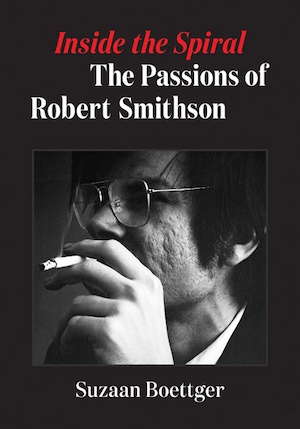By Svetlana Alpers
This is a book with a mission. Boettger, an intelligent and highly informed writer, challenges one’s sense (my sense, indeed) of the American artist Robert Smithson (1938-1973) as a cool, measured, distanced maker of post-modern objects and texts by insisting on the central importance of the passions founded in his early life and visible in his (mostly) over-looked early works. Born one year after the death of Harold, his nine year older brother, Smithson was or, most importantly as presented here, felt himself to be a “replacement child,” haunted by imaginings of the terrible, bloody death from the form of leukemia which had killed the brother he never knew.
Born in New Jersey, he came in to New York City when still in high school to study at the Art Students League and fell in with or was picked up by a group of determined and well-placed friends, including the son of the writer Meyer Levin who wrote early and strong praise of Smithson and his art. Despite the oddity of his mind and art, the record is that through his short life (it is hard to believe that he was 35 when he died) Smithson attracted devoted supporters in the art world and had many accomplished, discriminating friends. One gallerist gave him a monthly stipend and first show in Rome in summer 1961 in and another gave him a show back in New York in fall 1962. By the age of 24 he was already known—but known for images that were figurative, Christological (his family was catholic, although he was never observant), erotically ambiguous and for searing paintings, frequently making use of the color red, which is here identified as the color of blood. The blood, it is also claimed, of his dead brother.
It was after that second, 1962 exhibition that, as Boettger puts it, Smithson devised a new persona and turned to work in a new medium. He transformed himself into a kind of sculptor and, leaving galleries and museums largely behind, worked in and on landscape. The best known of his new works is the 1970 construction, made out of rocks and turning in on itself off the shore of the great Salt Lake, known as the Spiral Jetty. The financial support for it he owed to yet another longtime supporter, the gallerist, and heiress, Virginia Dwan. I should add that the ultimate supporter was Smithson’s wife Nancy Holt (an artist herself) who never remarried after his death and used a Holt-Smithson Foundation to memorialize his work.
He was also working, one should add, in his own mind—repeatedly writing illuminating statements about the basis of his art many of them published in the recently founded Artforum magazine. Smithson was as much an artist in words as he was an artist in earth. And curiously for someone as successful at building (whether ideas in the mind, or the books collected on shelves to make his library or earthworks) his abiding theme was entropy—a hard-to-define concept deriving from physics that he appropriated to his interest in the dissolution of all things towards an equilibrium as or in disorder. The disappearance and reappearance of his construction known as the Spiral Jetty seems to be a material confirmation of Smithson’s theme.
But what of Boettger’s theme—that seeks to make Smithson’s biography the basis of the interest of his work? That does not seem to me to be the question this book raises.
It seems to me what is missing here is the acknowledgement that Smithson is not alone. Many artists start out caught up in or is it trapped by their own passions. Many artists, indeed many great ones, start out this way and then take a turn to a more detached, and ordered attention to the world. A famous one is Cezanne: he turns away from his passionate, often violent early narrative paintings worked in thick oil paint to attend, primarily, to world as landscape worked in a new measured style. Cezanne understood this about himself and his work: “My method if I have one,” he boldly remarked to Gasquet, “is based on hatred of the imaginative.” We might compare that to Smithson quoted by Boettger as saying, ”I began to function as a conscious artist around 1964-65. I think I started then doing works that were mature. . . prior to [that] I was in a kind of groping, investigating period.”
Coming as I do from looking at historic European painting, I would add the example of Vermeer to these modern artists. Vermeer’s early works were narratives that were openly gestural and could even be bawdy. But Vermeer now, not wrongly, is treasured for his turn to the distanced, even cool, view of (mostly) women in domestic settings. For Smithson as for Cezanne and Vermeer, we are wise to keep in mind and eye Lawrence Gowing’s admonitory words on Cezanne, ”Everything of the passionate poetic youth was still there within him all his life.“
In a way. Boettger’s book sets showing that as one task for writers on Smithson who come after her.
Svetlana Alpers, an artist, critic, and renowned art historian, is professor emerita of the history of art at the University of California, Berkeley and a visiting scholar in the Department of Art History at New York University.




